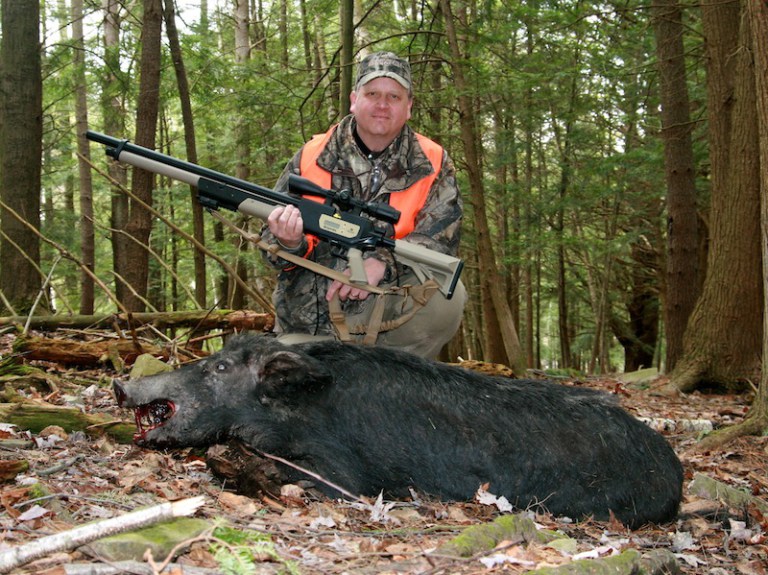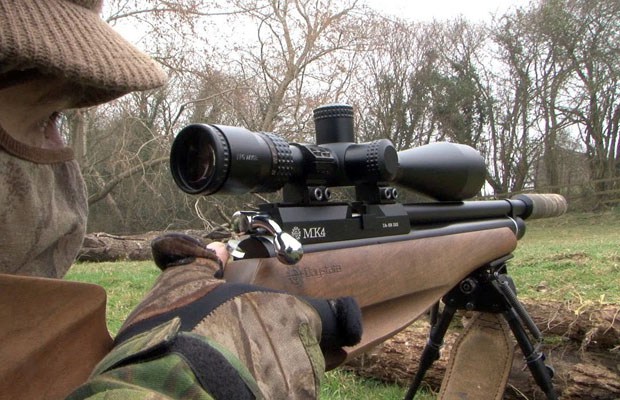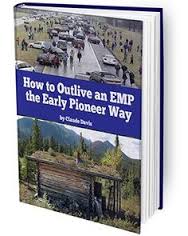There have been some recent articles and comment discussions about airguns. It’s awesome to see them evolving from the perception as solely a toy to potential tools within the preparedness crowd.
It’s my hope to explain some of the terminology that’s been used so people understand what might best suit their uses and avoid some of the feelings that can come from going to a retailer with unrealistic expectations or the wrong word. We’ve all been there with *that* clerk.
To that end, I put together a primer that explains some of the differences between BB and pellet guns, various types of airguns for preppers, and some resources for comparison charts and additional information.
Some practical applications for airguns follow if you can slog through the data.
Airgun options
First, there is a difference between a pellet gun and a BB gun – but they’re both airguns (so are airsoft guns).
Wait for it, this here is big:
BB guns shoot BBs – round balls like shot, readily available in steel and copper.
Pellet guns shoot pellets – generally pawn- or rook-shaped chunks of lead or alloy with a hollow cone at the rear.
Some airguns will fire both BBs and pellets, but the names are not interchangeable. That’s because the ammo has very different characteristics.
BB guns are for plinking. Pellet guns are designed for high accuracy and can offer hunting-level penetration.
BBs can regularly achieve at least slight increases in velocity over pellets, but they are less aerodynamic and offer less accuracy and decreased penetration due to the shape. The ball shape also lends a higher ricochet risk with BBs.
Pellets are designed to spiral on a tight trajectory. They come in a wide variety of nose types, just like firearm ammunition. As with firearm ammunition, the different nose shapes are tailored toward different functions.
Pellet quality really does affect accuracy. Happily, it’s usually a difference of $1-4 over 200+ pellets between the hum-drum can and the zingers.
You can find more information about pellet shapes and pellet weight here http://www.straightshooters.com/general-airgun-information.html and here http://www.straightshooters.com/pellet-head-shapes.html . Crossman also offers a primer about pellets and BBs here https://www.crosman.com/discover/airguns/airgun-ammunition .
BBs will strip out the rifling on an airgun that shoots both, so from a preparedness standpoint, some restraint is advisable there.
Action type matters
There are four basic types of airguns. In general order of power or velocity (there are always exceptions), they are: PCP (pre-charged pneumatic), break-action (spring or gas piston), variable- or multi-pump, and CO2.

Benjamin BTAP22SX Armada .22 PCP Rifle, Black
PCP airguns use a pump or air compressor to build up pressure. They can reach very, very high velocities and there are platforms that offer multiple shots, but there is the drawback of the additional equipment – those pumps.
Because of the air tanks both PCP and CO2 airguns possess, sometimes even a single shot gun only requires opening the world’s tiniest bolt to insert the next pellet.
PCP’s tend to be pretty expensive. I don’t need a $400-$2,000 gun to bring home any kind of burger or roasts.

Gamo Silent Cat air rifle
Break-action airguns use the leverage after breaking the barrel open to cock a piston. Next to PCP, these are typically the highest powered. They are my preferred pellet gun for hunting, but they do have drawbacks.
One drawback is the cocking effort. It may take 30+ pounds of pressure to cock a pellet gun that reaches 600-800+ feet per second (fps) in .22 or a 1000+ fps in .177 (generally accepted as hunting velocities).
That’s not something everybody can handle.
The second drawback, in comparison to some PCP and CO2-cartridge airguns, is that you only have that single shot before you need to re-cock the gun and reload.
There’s a new kid on the break-action market, the nitro piston. Instead of a spring, the piston assembly compresses nitrogen gas.
Without spring wear, it doesn’t need fired off, re-cocked and reloaded as often. You’ll still want to release it periodically (4-6 hours), but it’s a whole lot better when trying to keep track of what time you bagged that bunny.
The nitro-piston system is also even quieter than the old spring-operated break-action airguns. There’s a pvvnngg and a clack, instead of the bwwaannngggg-clunk.

880 Powerline Kit, Dark Brown/Black, 37.6 Inch
Variable pump or multi-pump airguns usually generate pressure by having the forend pumped. The cocking effort gets harder as pressure builds.
One of the advantages to a variable-pump airgun is that it is variable. A child or new shooter can pump just once or twice while developing fundamentals, then as skill grows, maximizes the pumps to extend their range. However, it requires a lot of motion and time to reload – and arm strength.
Some multi-pump pellet guns can achieve hunting-level velocities, but many are not going to reach the velocities needed for hunting even the smallest animals at anything over 10-20 yards or so. Still, there are models under $75-100 that work well enough for crows and pests – many with the accuracy to get a head shot and ensure a clean kill.

Winchester 990004-402 Hunting Air Rifle
CO2-operated airguns use a cartridge of compressed air to generate their power. One of the major advantages to this system is the ability to take multiple shots without reloading, or to reload just the ammo and continue to shoot.
CO2 pellet rifles and pistols usually don’t surpass the 400-600 fps range. That is too low to just barely enough for a .22 pellet for responsible, clean kills on targets like squirrels and rabbits. It’s not enough for a .177 caliber.
Many are only good for 20-50 shots at their highest velocity before they need a new cartridge. The power-loss slump is pretty steep after that. The cartridges can also slowly leak while the airgun sits unused, so it’s a good idea to lay on plenty of spares.
Why do caliber and velocity matter?
To get clean, humane kills that don’t require us tracking far, I need a projectile to both penetrate and deliver a forceful blow.
A .177 is going to travel faster, just like alloy. A .22 or lead pellet is going to travel slower out of the same platform, but because it’s larger and heavier, it can get away with a lower velocity to get a kill shot.
There are several resources that can help make a decision on a pellet gun for hunting.
PyramidAir breaks down velocity factors in the “How much power?” section of this page http://www.pyramydair.com/article/Airgun_Hunting_April_2012/83.
Stoeger has a chart about halfway down on this page http://usa.stoegerairguns.com/how-to-choose-an-airgun that compares its models by velocity and purpose among other things, and this page http://usa.stoegerairguns.com/airgun-hunting lists the distances various game and pests can be taken with its various models. Together, they offer a comparison of distance and game types by velocity and caliber.
***I am not in any way affiliated with Crossman, Stoeger, or any other website mentioned. Nor am I pushing a purchase from them – the charts allow you to find a best fit, then match an air rifle to the those specs while shopping around.
Airguns for Self-Defense?
No. Nor is my crossbow or muzzle loader – they take deer. As a training aid, however, airguns can excel.
Some of the CO2 BB guns, especially, very closely resemble the size, weight, sights, and operation mechanics of fairly common self- and home-defense firearms. Some of the similarities even extend to realistic magazine or speed clips that allow good reload practice.
The velocity limitations of CO2-operated airguns mean safe shooting ranges can be cheaply and easily erected in backyards and basements even for new shooters. (Always wear eye and ear protection.)
Buying and feeding an air-gun for actual follow-up-shot and draw-and-fire practice is both quieter and less expensive than even rim-fire shooting.
That means more practice is possible for more people.
Airguns for hunting
An airgun is more than a good starting point for non-rural dwellers, brand-new shooters, and beginning preppers on tight budgets. It can also be a great addition for longtime hunters.
It’s a regular tool for me.
Me? I’m a once-a-Marine combat correspondent who carried an M16, M9 and M4 on various deployments. I am an NRA range safety officer, private-club safety officer, and private-club new-shooter orientation instructor. I assist with several concealed-carry/wear-and-carry classes and act as range officer and assistant for a slew of classes and sporting events. I shoot a handful of disparate sports from Cowboy Action to modern sporter.

I’ll bet I’ve put more in the freezer using a 1000+ fps pellet gun and a shotgun than with my rimfire or centerfire guns.
I am a hunter – touching on 25 or 30 years in the fields and woods now. I’m the kind of hunter who bought a muzzle loader and a crossbow because not only do we get an early start on the season, in many states, we get extra tags.
I have all kinds of firearms for all kinds of purposes, because one size does not fit all. Airguns fill a fabulous niche for me.
I’ll bet I’ve put more in the freezer using a 1000+ fps pellet gun and a shotgun than with my rimfire or centerfire guns. Some of that is because I regularly carry a pellet gun again, even when I’m carrying something else as well.
When I was single and on my own but for dogs, I spent two years hunting almost all our meat. When you’re looking at more beans or breaking down and buying Big Ag chicken for the dogs, you learn to take what Mother Nature gives you.
At that time and again now, I usually have to travel some distance to find deer (unless the poor baby fruit trees are budding out).
But small game, now … they’re all over.
There’s an awful lot of game I’d have wasted down to toenails and fluff if all I’d had was a .357 and a .308 on me.
There’s also an awful lot of game that gets savvy pretty quick around us, and even a .22LR will send Bambi and Thumper racing for cover and staying tucked in during high season.
I have never lived somewhere – East Coast to Southwest, urban or ‘burbs or country – that the doves, crow, quail, pigeons, chipmunks, squirrels, rabbits, groundhogs, and prairie dogs did not greatly outnumber the pigs, deer, and bear. Should true need arise, I know waterways and I will add sitting rail, duck and geese to the first list.
That means I will most likely in the future – as I do now and did when I started – have more potential targets that can be taken with a pellet gun than those that require me to have a center-fire hunting platform.
(Do not wingshoot with a single projectile, ever, please.)
I have been able to take more animals without busting other game with an air rifle than I have with even a subsonic .22LR, and without other hunters knowing I was nearby until I started waving my hat (wildly – please know your target and beyond).
What does that mean?
I can spend more time out with a shotgun because I have to wait longer for the woods to settle again or travel further before a wait-and-listen. Or, I can bag several squirrels or birds in a shorter space of time with an air rifle, feed my family, and go do something else. Bonus: I can do it with less projectile damage to the meat.
I can do it at 20 and 50 yards, with a $75-125 pellet rifle. That’s not that much more limited than dove and rabbit shot, really, and about as far as I trust the accuracy and velocities of subsonic .22LR ammo.
Is an airgun for you?
Maybe not, but it might be.
If you think it is, and you want it for hunting, make sure to check those charts and get good reviews so your rifle matches your needs and desires. Invest in finding the best pellets for the airgun.
You might just be surprised how much quiet and small can put on the table while the big guns draw a blank or a one-off.
source: The Prepper Journal






